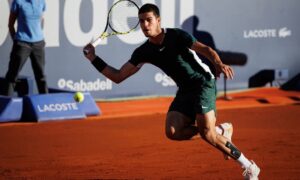 The European clay court season is now in full swing, leading up to the grand finale – the French Open fortnight in Paris, which kicks off on 28th May. Players are as divided on the subject of playing on the “red dirt” as they are about playing on the Wimbledon grass. Each of those surfaces has its specialists.
The European clay court season is now in full swing, leading up to the grand finale – the French Open fortnight in Paris, which kicks off on 28th May. Players are as divided on the subject of playing on the “red dirt” as they are about playing on the Wimbledon grass. Each of those surfaces has its specialists.
Daniil Medvedev clearly hates the clay, although he did have a fairly decent run in Barcelona. He is certainly right about the surface’s lack of predictability. “Every bounce is a bad bounce. And even when it’s a good bounce, you are expecting a bad bounce,” he says — which effectively makes every bounce “a bad one”. Medvedev is certainly aware that his flat groundstrokes don’t suit the surface: they just sit up, waiting to be crushed.
They are in total contrast to Rafa Nadal’s massive topspin groundstrokes, which clear the net by several feet, dip well inside the court and then rear up to the height of the opponent’s shoulder. It needs serious strength to deal with those balls. Over the past two decades, Rafa has played them in machine-like fashion over and over, until he exhausts the opponent both mentally and physically. It’s no coincidence that the great Spaniard has won an astonishing 14 French Open Slam titles by playing such percentage tennis. I doubt that this feat will be repeated in my lifetime.
The Greek player, Stefanos Tsitsipas, clearly also relishes the clay, likening the surface to an artist’s canvas, “ready to be painted on in all its beauty. The purest form of tennis is played on red clay.” He also talks about needing “the patience of a donkey” and makes mention of “unicorns on skateboards”: his references can be rather obscure. But Tsitsipas seemed destined to win his first Grand Slam title in Paris in 2021, leading 2 sets to 0 against Djokovic, before folding in the final three sets. Perhaps this will be the year he finally wins a Slam? Certainly, this surface is his best chance.
As for the new kid on the block, the 19-year-old Spaniard Carlos Alcaraz, he grew up on the stuff. The Spanish players all have — they play like metronomes, a trick they learned from Rafael Nadal. Watching two Spaniards battling it out on clay? Be careful your passport doesn’t expire.
Instead of broaching the subject verbally, Alcaraz lets his racket do the talking. In the final at Barcelona, he took Tsitsipas apart in straight sets by the convincing scoreline of 6-3, 6-4. Sure, there was a bit of a nervy start when Alcaraz thrashed at the ball, frequently snatching at it and overhitting. But when he settled down, he showed us why he was the world’s number one player after his victory at the US Open last September at the age of just 19. Being on his home turf, with the Spanish crowd on his side, obviously helped too.
Alcaraz hit some thunderous groundstrokes, pinning his opponent right at the back, almost against the stop netting, and then, with perfect disguise, feathered his trademark drop shot, leaving the Greek stranded and bewildered. Tsitsipas attempted to nullify those drop shots by standing further into the court which simply meant he had to take those thunderbolts on the rise, an almost impossible feat when faced with a potentially tricky bounce. Poor Tsitsipas just kept framing them.
It would have been interesting to see Alcaraz pitted against his mentor, except that Nadal was out with an injury and unable to play in Barcelona. It’s quite possible that Rafa, now 36, won’t be fit enough in time for his beloved French Open.
The other big gun, Novak Djokovic, may also be out of the French. He has a recurring elbow injury and is clearly not match-fit, having missed the whole of the American hardcourt season. He still refuses to take that Covid vaccine and the US tennis authorities have continued to put their foot down, denying him entry to their events. And you can practise all you like, but it doesn’t compare to match play. The real thing takes far more of a toll as it’s also emotionally exhausting.
All of which means Alcaraz is looking good for the French Open title at Roland Garros next month. His main rival on this surface, Stefanos Tsitsipas, may, however, have come up with some cunning new plan after his thrashing in Barcelona. It would be fascinating to witness a rematch — this time in a Grand Slam event which takes place over a fortnight and the best of five sets. That’s the real test of a player’s mettle in the men’s game.
Roll on the French Open: it promises to be very interesting in its own right this year, not just as the curtain-raiser for Wimbledon.